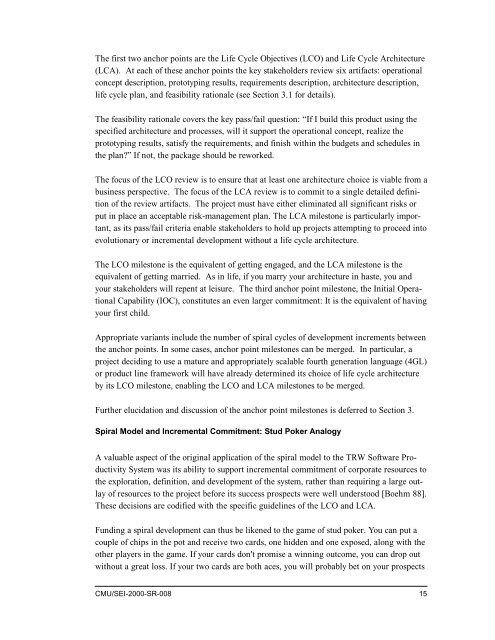00sr008
00sr008
00sr008
You also want an ePaper? Increase the reach of your titles
YUMPU automatically turns print PDFs into web optimized ePapers that Google loves.
The first two anchor points are the Life Cycle Objectives (LCO) and Life Cycle Architecture<br />
(LCA). At each of these anchor points the key stakeholders review six artifacts: operational<br />
concept description, prototyping results, requirements description, architecture description,<br />
life cycle plan, and feasibility rationale (see Section 3.1 for details).<br />
The feasibility rationale covers the key pass/fail question: “If I build this product using the<br />
specified architecture and processes, will it support the operational concept, realize the<br />
prototyping results, satisfy the requirements, and finish within the budgets and schedules in<br />
the plan?” If not, the package should be reworked.<br />
The focus of the LCO review is to ensure that at least one architecture choice is viable from a<br />
business perspective. The focus of the LCA review is to commit to a single detailed definition<br />
of the review artifacts. The project must have either eliminated all significant risks or<br />
put in place an acceptable risk-management plan. The LCA milestone is particularly important,<br />
as its pass/fail criteria enable stakeholders to hold up projects attempting to proceed into<br />
evolutionary or incremental development without a life cycle architecture.<br />
The LCO milestone is the equivalent of getting engaged, and the LCA milestone is the<br />
equivalent of getting married. As in life, if you marry your architecture in haste, you and<br />
your stakeholders will repent at leisure. The third anchor point milestone, the Initial Operational<br />
Capability (IOC), constitutes an even larger commitment: It is the equivalent of having<br />
your first child.<br />
Appropriate variants include the number of spiral cycles of development increments between<br />
the anchor points. In some cases, anchor point milestones can be merged. In particular, a<br />
project deciding to use a mature and appropriately scalable fourth generation language (4GL)<br />
or product line framework will have already determined its choice of life cycle architecture<br />
by its LCO milestone, enabling the LCO and LCA milestones to be merged.<br />
Further elucidation and discussion of the anchor point milestones is deferred to Section 3.<br />
Spiral Model and Incremental Commitment: Stud Poker Analogy<br />
A valuable aspect of the original application of the spiral model to the TRW Software Productivity<br />
System was its ability to support incremental commitment of corporate resources to<br />
the exploration, definition, and development of the system, rather than requiring a large outlay<br />
of resources to the project before its success prospects were well understood [Boehm 88].<br />
These decisions are codified with the specific guidelines of the LCO and LCA.<br />
Funding a spiral development can thus be likened to the game of stud poker. You can put a<br />
couple of chips in the pot and receive two cards, one hidden and one exposed, along with the<br />
other players in the game. If your cards don't promise a winning outcome, you can drop out<br />
without a great loss. If your two cards are both aces, you will probably bet on your prospects<br />
CMU/SEI-2000-SR-008 15














